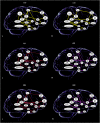Altered structural and effective connectivity in anorexia and bulimia nervosa in circuits that regulate energy and reward homeostasis
- PMID: 27801897
- PMCID: PMC5314116
- DOI: 10.1038/tp.2016.199
Altered structural and effective connectivity in anorexia and bulimia nervosa in circuits that regulate energy and reward homeostasis
Abstract
Anorexia and bulimia nervosa are severe eating disorders that share many behaviors. Structural and functional brain circuits could provide biological links that those disorders have in common. We recruited 77 young adult women, 26 healthy controls, 26 women with anorexia and 25 women with bulimia nervosa. Probabilistic tractography was used to map white matter connectivity strength across taste and food intake regulating brain circuits. An independent multisample greedy equivalence search algorithm tested effective connectivity between those regions during sucrose tasting. Anorexia and bulimia nervosa had greater structural connectivity in pathways between insula, orbitofrontal cortex and ventral striatum, but lower connectivity from orbitofrontal cortex and amygdala to the hypothalamus (P<0.05, corrected for comorbidity, medication and multiple comparisons). Functionally, in controls the hypothalamus drove ventral striatal activity, but in anorexia and bulimia nervosa effective connectivity was directed from anterior cingulate via ventral striatum to the hypothalamus. Across all groups, sweetness perception was predicted by connectivity strength in pathways connecting to the middle orbitofrontal cortex. This study provides evidence that white matter structural as well as effective connectivity within the energy-homeostasis and food reward-regulating circuitry is fundamentally different in anorexia and bulimia nervosa compared with that in controls. In eating disorders, anterior cingulate cognitive-emotional top down control could affect food reward and eating drive, override hypothalamic inputs to the ventral striatum and enable prolonged food restriction.
Conflict of interest statement
The authors declare no conflict of interest.
Figures


References
-
- Crow SJ, Peterson CB, Swanson SA, Raymond NC, Specker S, Eckert ED et al. Increased mortality in bulimia nervosa and other eating disorders. Am J Psychiatry 2009; 166: 1342–1346. - PubMed
-
- Becker AE, Grinspoon SK, Klibanski A, Herzog DB. Eating disorders. N Engl J Med 1999; 340: 1092–1098. - PubMed
-
- Halmi KA, Sunday SR. Temporal patterns of hunger and fullness ratings and related cognitions in anorexia and bulimia. Appetite 1991; 16: 219–237. - PubMed
-
- Strober M, Freeman R, Lampert C, Diamond J, Kaye W. Controlled family study of anorexia nervosa and bulimia nervosa: evidence of shared liability and transmission of partial syndromes. Am J Psychiatry 2000; 157: 393–401. - PubMed
Publication types
MeSH terms
Substances
Grants and funding
LinkOut - more resources
Full Text Sources
Other Literature Sources
Medical

